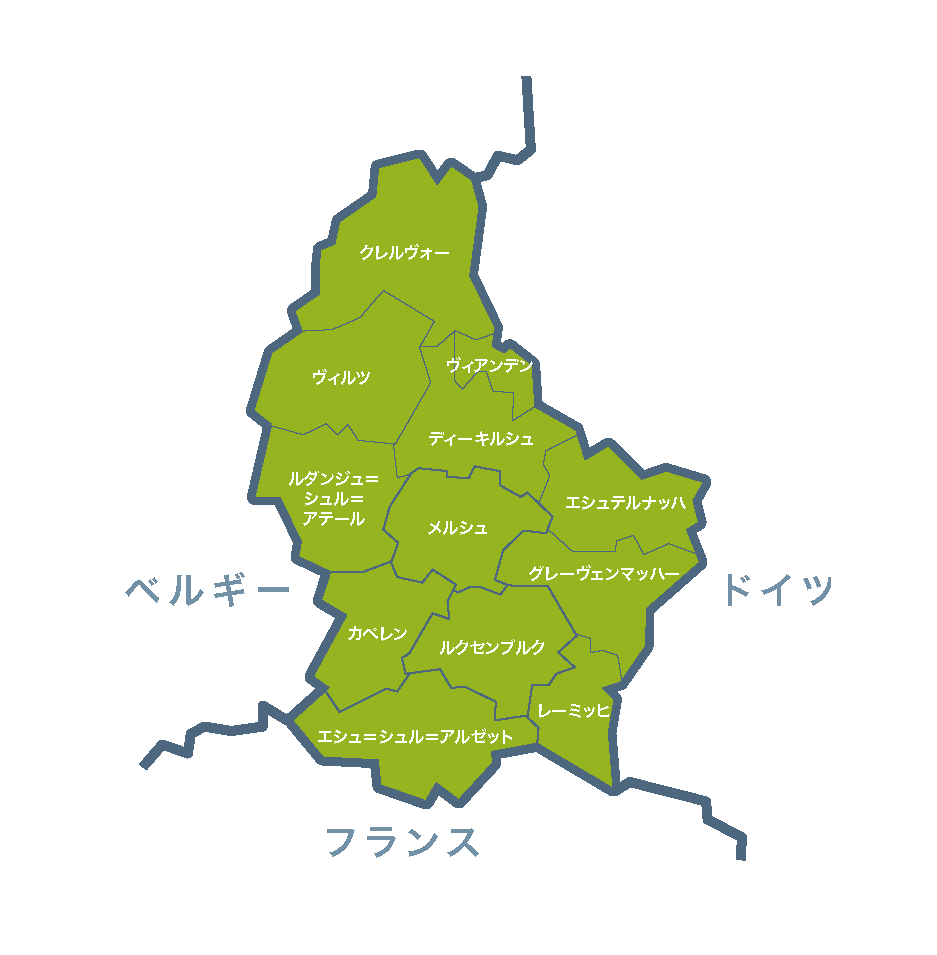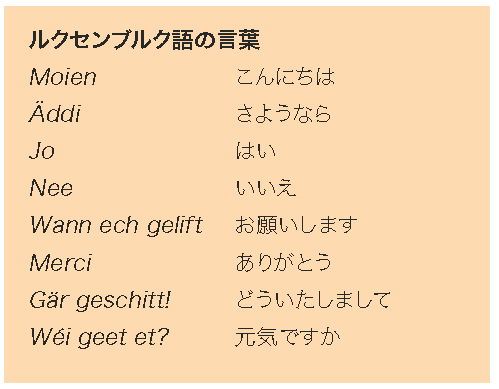ABOUT LUX ルクセンブルクの基本情報
Quick Guide
Official designation
ルクセンブルク大公国
Grand Duchy of Luxembourg
Capital
ルクセンブルク
Luxembourg
National day
6月23日
23 June
Currency
ユーロ
Euro
Geography
Area
2,586km²。このうち、85.4%が農地もしくは森林 (2013)
2,586 km2, of which 85.4% is farmland or forest (2013)
Neighbouring countries
ベルギー、ドイツ、フランス
Belgium, Germany, France

general
西ヨーロッパの中心に位置するルクセンブルクは、ベルギー、ドイツ、フランスに囲まれています。 地勢により、北部のウスリング地方、南部のグートランド地方の2つに大きく分かれています。グートランド地方は、東にモーゼル渓谷、南に鉱物資源の豊富 な盆地を擁しています。 変化に富んだ 景観はルクセンブルクの最大の魅力の1つです
The Grand Duchy of Luxembourg is located in the heart of Western Europe between Belgium, Germany and France. It has two natural regions: the Oesling in the north and the Gutland, comprising the Moselle valley in the east and the mineral basin in the south.
Variegated landscape is one of the biggest attraction of Luxembourg.
Population
Total population
54万9,700人。全人口の45.3%を占める24万8,900 人は外国人居住者 (2014年1月現在)
549,700 inhabitants, including 248,900 foreign residents representing 45.3% of the total population (January 2014)
Languages
ルクセンブルクの言語環境の特徴としては、ルクセンブルク語とフランス語、ドイツ語の3言語が公用語として認められ、用いられていることが挙げられます。
The linguistic situation in Luxembourg is characterised by the use and legal recognition of three languages: Lëtzebuergesch, French and German.
National language
ルクセンブルク語
Lëtzebuergesch
Administrative languages
フランス語、ドイツ語、ルクセンブルク語
French, German, Lëtzebuergesch
The sociopolitical dimension of multilingualism
多言語主義はルクセンブルクの日常生活に深く根 づいており、社会のあらゆるレベルに浸透しています。 一般的には、国語であるルクセンブルク語が職場、 学校、家庭でもっとも広く話されています。ポルトガル語を話す大きなコミュニティがあることを反映して、次によく話されているのはポルトガル語、その後 にフランス語とドイツ語が続きます。ただし、言語環境は話題となるトピック(分野)によって少しずつ異なります。
Multilingualism has deep roots in the everyday life of the country and permeates every level of society. In general, Lëtzebuergesch – the national language – is the most widely spoken language at work, at school and/or at home. Portuguese is in second place, reflecting Luxembourg’s large Portuguese- speaking community, followed by French and German. The linguistic situation is more nuanced, however, depending on context.
Professional and social life
ルクセンブルクにおける社会生活では、地域や活動内容によって多少の違いはあるものの、複数の言語 がごく自然に共存し、時には同時に用いられること もあります。 労働人口に外国人居住者や、フランス・ベルギー・ドイツからの越境通勤者が占める割合が多いため、 職場でのコミュニケーションの手段としては、フランス語が最も一般的に使われています。次いで、ルクセンブルク語、ドイツ語、英語、ポルトガル語が使われます。
商業施設や、ホテル、レストラン、カフェなどでよく使 われているのはフランス語で、特に首都やその近辺ではその傾向が強く見られます。唯一の例外は北部地方で、フランス語よりもルクセンブルク語の方が優勢です。
EU機関や金融機関、製造・サービス業でも組織が 大きく国際的な場合は英語が共通語として使われています。 ポルトガル移民のコミュニティが大きいことから、職場や余暇を過ごす場では、ポルトガル語が使われていることもよくあります。
Public life would be unthinkable without the coexistence and even the simultaneous use of several languages, with variations according to location and activity. Since the working population is mostly made up of foreign residents and French, Belgian and German cross-border commuters, French is the main medium of communication, followed by Lëtzebuergesch, German, English and Portuguese.
French is used particularly in trade, hotels, restaurants and cafes, mainly in the capital and surrounding area. The north of the country is the exception to the rule as it is the only region where Lëtzebuergesch is more widespread than French.
English is the lingua franca of the large internation- al community working in European institutions and staff in the banking and industrial sectors. Because the community of Portuguese immigrants is so large, they often use their mother tongue in the workplace as well as during their leisure time.

Political system
Form of government
立憲君主制のもとでの議会制民主主義
Parliamentary democracy within the framework of a constitutional monarchy
Head of state
アンリ大公 (2000年10月7日即位)
HRH Grand Duke Henri (acceded to the throne on 7 October 2000)
general
ルクセンブルク大公国は、1839年4月19日にロンドン条約が締結されて以来、独立した主権国家です。 立憲君主制のもとでの議会制民主主義を採用し、ナッサウ家が代々、国家元首を世襲で継承しています。 議会制民主主義の常として、ルクセンブルクでも、権力は柔軟に分散されています。立法権と行政権の間 には多くのつながりがあります。司法権だけが完全に 独立しています。
The Grand Duchy of Luxembourg, a sovereign and independent state since the Treaty of London of 19 April 1839, is a parliamentary democracy within the framework of a constitutional monarchy, in which the crown is passed down through the Nassau family. As in all parliamentary democracies, the separation of powers is flexible in Luxembourg: there are many links between the legislative and executive powers. Only the judicial power is totally independent.
History
origins
ルクセンブルクの名称は、963年頃にジークフロイト伯爵がトリアーの聖マクシミン修道院から小さな砦を取得した時の契約書に初めて登場します。砦は、「ボック」として知られるアルゼット渓谷からそそり立つ岩崖の上にあり、「小さな砦」を意味するリュシリンブルフク(Lucilinburhuc)と呼ばれていました。 これがルクセンブルクの名前の由来です。
The name Luxembourg (Lucilinburhuc) first appears around 963 in a deed of barter in which Count Siegfried acquired from the abbey of St Maximin of Trier a small fort situated on a rocky outcrop dominating the Alzette valley, commonly called the Bock.
National symbols
National flag
最初の国旗として知られているのは、1123年にルクセンブルク伯ギヨーム1世が用いたものです。黄色と赤の横縞模様の旗だったと考えられています。 現在のルクセンブルク国旗は、赤・白・空色の水平3色旗です。オランダの国旗に似ていますが、オランダの国旗は空色の代わりにコバルトブルーを用いています。
The first known flag was carried by Count William of Luxembourg in 1123. It was barred, i.e. horizontally striped, probably yellow and red. The current Luxembourg flag is made up of three horizontal bands of red, white and sky blue. The Luxembourg flag bears a close resemblance to the flag of the Netherlands, but the latter has a distinctive cobalt blue stripe.
ルクセンブルクの紋章の起源は中世にさかのぼります。定めたのはルクセンブルク伯アンリ5世で、 1235年頃のことでした。大公紋章には、小紋章、中紋章、大紋章という3つの種類があります。銀白と青の10本の横帯に、後ろ足 で立ち上がった赤色のライオンが描かれています。 ライオンは冠をかぶり、爪を立て、舌を出していて、二股に分かれた尾が交差しています。
この紋章は1972年6月23日付の国章法で法的に保護されており、さらに1993年7月27日の法律で、同法の改正と補遺が行われました。
ルクセンブルクの国旗と紋章は、1972年6月23日付の国章法によって保護されています。
The origins of the state of Luxembourg’s coat of arms date back to the Middle Ages. It was established in around 1235 by Count Henry V of Luxembourg. The coat of arms of the Grand Duchy of Luxembourg has three levels: lesser, middle and greater. It is barry of ten argent and azure with a lion rampant gules, crowned, armed and langued in gold with a forked tail crossed in saltire.
The coat of arms has enjoyed legal protection under the law on national emblems of 23 June 1972, amended and supplemented by the law of 27 July 1993.
The Luxembourg flag and state coat of arms are protected by the law on national emblems of 23 June 1972.
National flag
ルクセンブルクの国歌は、1859年の『Ons Heemecht 我が祖国』の最初と最後の詩節から構成されており、平和への願いを歌ったものです。平和と繁栄を想起させる雰囲気に包まれており、1839年に独立を成し遂げた時のおおいなる喜びを表現しています。
The first known flag was carried by Count William of Luxembourg in 1123. It was barred, i.e. horizontally striped, probably yellow and red. The current Luxembourg flag is made up of three horizontal bands of red, white and sky blue. The Luxembourg flag bears a close resemblance to the flag of the Netherlands, but the latter has a distinctive cobalt blue stripe.
(ナショナルデー)
National day
ルクセンブルクでは、18世紀末から君主の誕生日を祝う習慣がありました。しかし、シャルロット女大公の誕生日は1月23日だったため、その長い治世(1919~1964年)の間、つねに真冬に行われていました。 主に気候上の理由により、1961年12月23日付の大公令で、君主の誕生日を国民が祝う日は、6月23日と定められました。祝典は前夜から始まります。
The custom of celebrating the anniversary of the birth of the sovereign has existed since the late 18th century. During the long reign of Grand Duchess Charlotte (1919-1964), this celebration took place in mid-winter on 23 January, the date of the sovereign’s birthday. A grand-ducal decree of 23 December 1961 set the date of the public celebration of the sovereign’s birthday and therefore that of national day as 23 June, largely for climatic reasons. Celebrations begin the evening before.
Economy
ルクセンブルクは、1840年代に南部で鉄鉱石が発見されたことがきっかけで、経済的に豊かになりました。フランス・ロレーヌ地方で産出される鉄鉱石の名称にちなみ、この地方全体が「ミネット」と呼ばれるようになり、それ以来、ルクセンブルクは農業国から工業国へと転身を遂げました。
Luxembourg owes its prosperity to the discovery of iron ore in the south of the country in the 1840s. This discovery gave its name to a whole region, Minett (from “minette”, the designation for iron ore in the Lorraine, France), and marked the transition from an agrarian to an industrial state.
Industry
19世紀半ばにさかのぼるルクセンブルク初期の産 業において圧倒的な割合を占めていた鉄鋼生産 は、1950年以降に大規模な成長を遂げました。同時に 金融セクターも発展しました。
2004年以降、政府は新たな経済多角化政策を実施し、複数分野での専門性構築に力を注いでいます。そのような分野は、情報通信技術、ロジスティクス、医療科学技術、環境技術など多岐にわたっています。
The early days of industry in Luxembourg, dating back to the middle of the 19th century, were dominated by steel production, which enjoyed con- siderable growth from 1950 onwards. During this period, Luxembourg also developed its financial sector.
social composition
Population
1870年頃に工業化が始まって以降、ルクセンブルクの人口は大幅に増加しました。最大の理由は、 19世紀後半以来、移民の流入が絶えなかったことにあります。1910年のルクセンブルクの人口は26万人でしたが、2014年1月には54万9,700人になっており、この約100年で人口は2倍以上に増えたことになります。
Luxembourg has experienced strong population growth since industrialisation began in around 1870. This can largely be explained by steady immigration since the late 19th century. In 1910, Luxembourg recorded 260,000 inhabitants; by January 2014, the population had risen to 549,700, having more than doubled in the space of a century.
A plural society
現在では、ルクセンブルクの人口の半数近くはルクセンブルク国籍ではありません。外国人居住者は 24万8,900人で、全人口の45.3%を占めています。 そのうち約86%は28のEU加盟国の出身です。ルクセンブルクには、実に160ヵ国以 上の国籍の人々がいます。
Nearly half the country’s population currently consists of non-Luxembourg citizens. There are 248,900 foreign residents, accounting for 45.3% of the total population, with approximately 86% of foreign residents coming from the 28 member states of the European Union. There are more than 160 nationalities present in Luxembourg. (source: “Everything you need to know about the Grand Duchy of Luxembourg” published in March 2015)